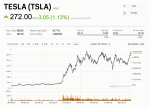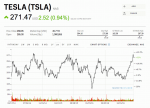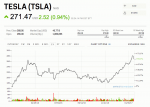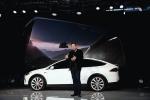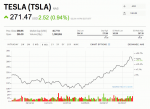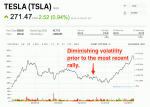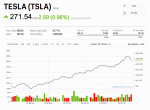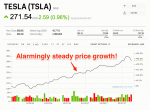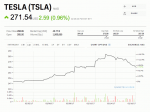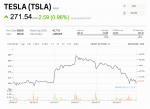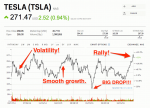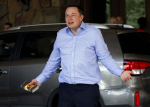Reuters/Mike Blake
Tesla is headed into fourth quarter and full-year 2016 earnings next week with arguably the biggest head of financial steam in the company's history.
A surprise profit in the third quarter last year, coupled with Donald Trump's win in the election and the assumption that an America-first manufacturing policy favors Tesla, has sent shares on an epic rally. The stock has risen as much as 50% of the past three months, surging toward $300 and ending last week above $270.
Tesla has watched its stock soar in the past, only to reliably plummet — or, if not that, the revert to trading levels that don't register a $40-billion-plus market cap, right up their with the Ford Motor Company, but something close to $30 billion, which in the assessment of many market pros is, frankly, bonkers for a carmaker that sold only about 80,000 vehicles in 2016.
The roller-coaster ride that is Tesla investing has certainly been intense, but over the past two years some interesting new patterns have developed. It's also worth taking into account that Tesla financial reporting and market value have gotten far more complex with the 2016 acquisition of SolarCity for just over $2 billion, a price that also bought Tesla billions in debt.
I thought it might worth it to take a look back at Tesla's history — a story in stock charts:
We'll start with the all-time chart, showing Tesla's share-price history since its 2010 IPO, when the company was trading below $20.Markets InsiderAs you can see from the chart, Tesla was basically flat for several years after the 2010 IPO. In 2008, the carmaker had endured a near-death experience, and in the lead-up to the IPO and afterwards, it was selling only one car, the original Roadster.
The game plan at this point was for CEO Elon Musk and his team to keep the lights on long enough the roll out Tesla's first built-from-scratch car, the Model S sedan.
That happened in 2012, and for 2013, Motor Trend named the Model S it Car of the Year. At this point, the stock took off.
And as you can see, if you bought Tesla right after the IPO and held on, you'd be looking at an 1,000%-plus return today.
The Model S launch was a defining event for Tesla. This would mark the beginning of Tesla's Wall Street story, the tale of a rapid-growth tech company. But ironically, it would also mark the moment at which Tesla started to become a car company.Reuters/Noah Berger
Over the past three years, however, Tesla's stock story has been one of extreme volatility: spikes and swoons.Markets Insider
Because Tesla took off so fast as a stock and quickly achieved an impressive market cap for a company that, in 2013, was selling almost no cars (even if the ones it was selling cost more $100,000 apiece), a stable price wasn't in the picture.
Investor confidence would soar, then collapse, with sentiment turning on ever news event, product announcement or delay, quarterly earnings report, and market-moving Muskian tweet.
Rapid run-ups were followed by jerky declines. Jagged recoveries presaged vertiginous descents. At one point, Musk himself said that the company was overvalued. Unlike the rest of the industry, with its slow, predictable stock behavior for publicly traded carmakers, and with its long business cycles, Tesla was behaving more like a Silicon Valley tech company.
Analysts fixated on the pace of deliveries as the best indicator of how Tesla was performing and whether there was sufficient demand for Tesla electric cars, in a market that otherwise didn't seem to want them, to justify the monumental valuation. Eventually, Tesla began reporting quarterly sales, mainly to give Wall Street something to go on.
The initial "Wow!" of the Model S also began to encounter some speed bumps, as publications such as Consumer Reports both enthused over the vehicle and noted some drawbacks. Tesla also spent years figuring our how to build the car at scale — the learning curve was much steeper than it should have been for an automaker in the 21st century.Flickr / Steve Jurvetson
That leads us to the past 12 months.Markets Insider
In 2015, the long-awaited Model X SUV was added to the lineup, enhancing sales and giving Tesla a vehicle to use to compete in the booming crossover market. But the Model X arrived three years late, and its tremendous complexity meant that Tesla spent the first half of 2016 sorting out myriad production issues.
Some compensation arrived in the form of the reveal of the Model 3 mass-market vehicle — $35,000 before tax breaks, with a 200-plus-mile range on a single charge. Tesla quickly racked up 373,000 pre-orders for the vehicle, at $1,000 a pop.
Meanwhile, Tesla had steadily improved the Model S, culminating in the P100D, whose blistering acceleration gave a better 0-60 mph time than many supercars. A massive Gigafactory battery plant was opened in Nevada, a new energy storage business was rolled out, and the SolarCity acquisition happened.
Wall Street was losing the thread, however. Tesla wasn't a very good car manufacturer, consistently missing its deliveries guidance, and investors began to figure this out. While the tech side of Tesla was doing some stunning stuff with Autopilot self-driving, a driver died in an accident while using the system in 2016, leading to uncertainly about Musk's ambitions.
The wild volatility had briefly faded, only to return. And until the tail end of 2016, Tesla was enduring a slow stock slide. Fortunately for Musk, the company has executed a capital raise before the skepticism set it.
See the rest of the story at Business Insider
See Also:
- The idea that a unionized Tesla factory will be a great labor win is an overstatement
- 23 innovative features in the new BMW 5-series
- Say hello to the 812 Superfast — the fastest and most powerful Ferrari in history
SEE ALSO: The idea that a unionized Tesla factory will be a great labor win is an overstatement
